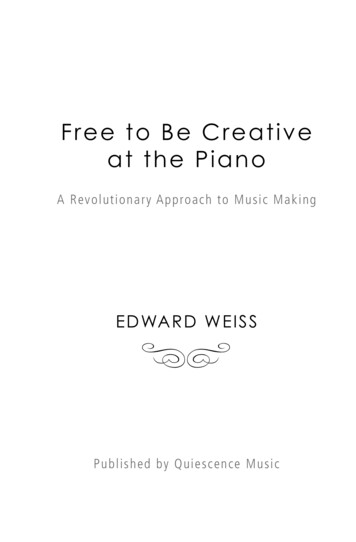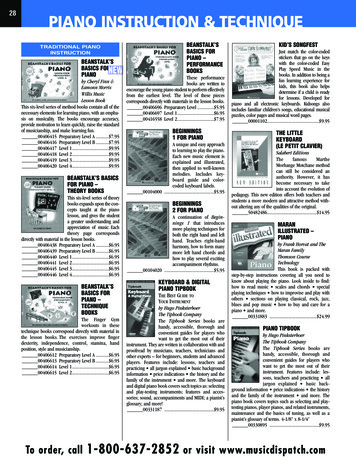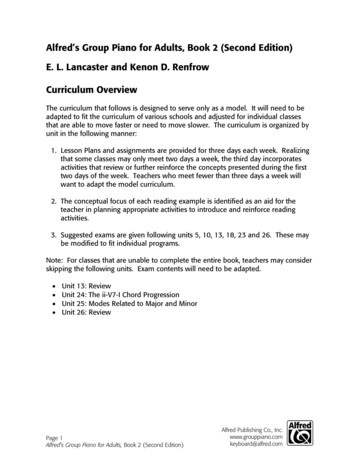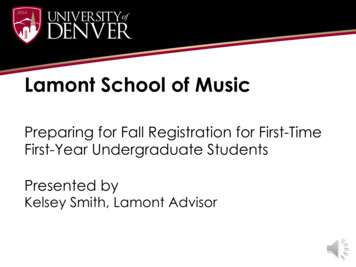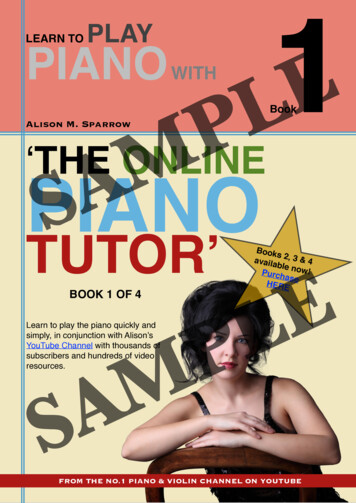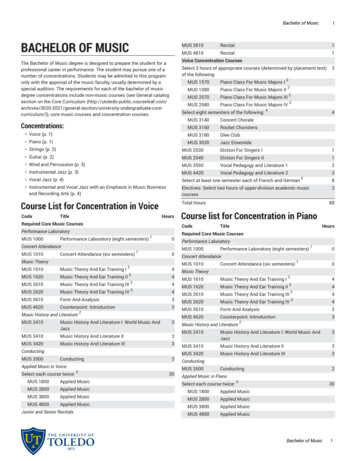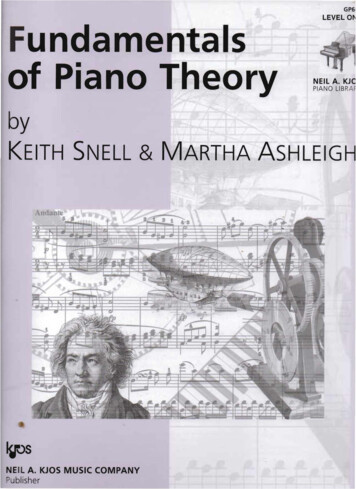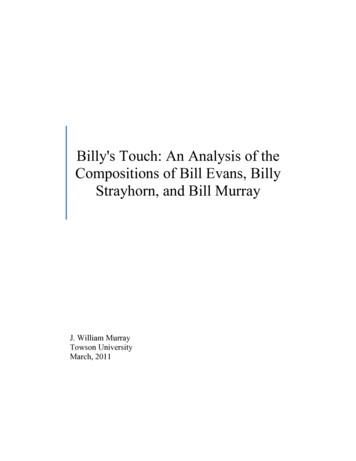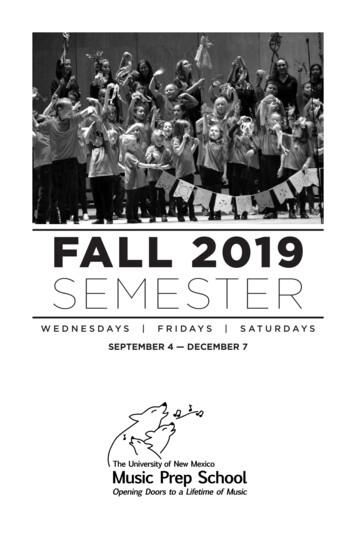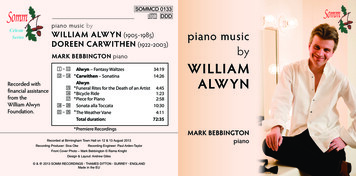
Transcription
sommcd 0133dddpiano music byCélesteSeriesWILLIA M ALW YN (1905-1985)DOREEN CARWITHEN (1922-2003)MARK BEBBINGTON piano1 – bm Alwyn – Fantasy Waltzesbn – bp * Carwithen – SonatinaRecorded withfinancial assistancefrom theWilliam AlwynFoundation.34:1914:26Alwynbq * Funeral Rites for the Death of an Artist 4:45br * Bicycle Ride1:23bs * Piece for Piano2:58bt – cl Sonata alla Toccata10:30cm – cq * The Weather Vane4:11Total duration:72:35*Premiere RecordingsRecorded at Birmingham Town Hall on 12 & 13 August 2013Recording Producer: Siva OkeRecording Engineer: Paul Arden-TaylorFront Cover Photo – Mark Bebbington Rama KnightDesign & Layout: Andrew Giles & 2013 SOMM RECORDINGS · THAMES DITTON · SURREY · ENGLANDMade in the EUpiano musicbyWILLIA MALW YNMARK BEBBINGTONpiano
Piano music byWilliam Alwyn & Doreen CarwithenMark Bebbington pianoAlwynbq Funeral Rites for the Death of an Artist – Slow and Poignantbr Bicycle Ride – Allegro leggierobs Piece for Piano – Molto moderato – Più mosso e più agitato –A tempo primo – Adagio molto4:451:232:58123456789blbmAlwyn – Fantasy Waltzes1. Tempo rubato e capriccioso2. Scherzando3. Moderato4. Grazioso5. Lento6. Allegro giocoso7. Lento8. Vivace, ma ritmico9. Lento e lugubre10. In Tempo piacevole11. :395:07The Weather Vanecm 1. The Weather Prophet – Andante con motocn 2. The West Wind – Allegro moderato e giocosoco 3. From the East – Andantino (quasi Allegretto)cp 4. The Sunny South – Tempo di valsecq 5. The North Wind Doth Blow – Allegro molto[4:11]1:050:420:430:560:43Carwithen – Sonatina[14:26]Total playing time72:35bn 1. Allegro moderato – Più lento Maestoso – Più mosso – Tempo 13:44bo 2. Molto adagio5:52bp 3. Allegro molto4:492Alwyn – Sonata alla Toccatabt 1. Maestoso – Allegro ritmico e jubilantebu 2. Andante con moto e semplicecl 3. Molto vivaceRecording Producer: Siva Oke[10:30]3:322:464:11Recording Engineer: Paul Arden-Taylor3
Piano music byWilliam Alwyn and Doreen CarwithenWilliam Alwyn was born in Northampton on the 7th November 1905 anddied in Southwold, Suffolk on 11th September 1985 just a few weeks shortof his 80th birthday. His musical studies (in flute, piano and composition)took place at London’s Royal Academy of Music, where in 1926 at the ageof twenty-one, he was appointed Professor of Composition; a position thathe was to retain for almost thirty years. Alwyn’s large corpus of work, whichis close to three hundred compositions, includes music in the majority ofgenres; opera, ballet, orchestral, chamber, instrumental and song. Hismajor orchestral works include five symphonies, and concertos for flute,oboe, violin, harp and piano. In addition to this there are approximatelytwo hundred film scores which include music for both documentaries andfeature films. Among the latter are several classic British films that drewfrom Alwyn some of his finest music for the genre: Odd Man Out, TheHistory of Mr. Polly, The Fallen Idol, and The Rocking Horse Winner. There isalso incidental music for both radio and television.In addition to composing and teaching Alwyn held many appointments onvarious committees including acting as Chairman for the Composers’ Guildof Great Britain for which he served three terms in 1949, 1950, and 1954. InWilliam Alwyn 1960 Wolf Suschitzky – used by permission45
1948 he was elected a member of the Savile Club thereby joining a numberof other British Savilian composers that include Richard Arnell, MalcolmArnold, Sir Arthur Bliss and William Walton. When not composing music,Alwyn spent his time writing and painting, such was his desire to alwaysbe creative. Among his writings is a short autobiography entitled WingedChariot, and perhaps most fascinating of all a diary that he kept betweenSeptember 1955 and August 1956 while composing his Third Symphony thatdocuments his daily routine composing for the cinema and concert hall.Alwyn was awarded a CBE in 1978 in recognition of his services to music.Several of these examination pieces found their way onto the Syllabus ofthe Associated Board of the Royal Schools of Music for which Alwyn wasan examiner during the 1930s.Alwyn produced approximately one hundred and fifty pieces for pianosolo during his composing career. His most significant works for thepiano are the Sonata alla Toccata, Fantasy Waltzes, Twelve Preludes andMovements. In addition to this there are also two piano concertos datingfrom 1930 and 1960 respectively. Alwyn was a very capable pianist andhis approach to writing for the piano was essentially that of a romantic.Even though he flirted briefly with neo-classicism his piano music was bornout of the tradition exemplified by Liszt and Rachmaninov, through to theimpressionism inherent in the music of Debussy and Ravel. The spirit ofJohn Ireland can also be felt, particularly in the smaller descriptive pieces.Influences aside however, Alwyn found his own individual way in writingfor the piano as can be heard from the selection of works presented here.His intuitive writing for the instrument resulted not just in virtuoso piecesfor the concert hall, but also sensitive miniatures of a highly expressivenature, along with many educational pieces for examination purposes.The Fantasy Waltzes is a suite of eleven virtuoso piano pieces composed inLondon between June 1954 and April 1955 and is arguably Alwyn’s finestcreation for piano solo. The obvious rôle models here are the waltzes ofChopin, Ravel and Johann Strauss. Alwyn, however, using the basic threefour rhythm with great variety of freedom of style, interprets the wholerange of the waltz in his own inimitable way. The idea for the FantasyWaltzes originated while Alwyn was on holiday in Norway after a visit toGrieg’s lakeside home. The third piece of the set, intended as a homage toGrieg and indeed inhabiting very much the sound world of the Lyric Pieces,was the first to be composed. At the head of the autograph manuscriptscore to this piece Alwyn has written “At the Tomb of Grieg”. Althoughconceived as a continuous cycle the suite does divide into two parts, Nos.1-6 and Nos. 7-11, which encompass many moods from happy to sad, tothe mysterious and funereal. The first part opens nostalgically and endswith the very rhythmic and joyous sixth waltz incorporating an expressivemiddle section. The seventh waltz, which opens the second part, is verysubdued and mysterious exploring the chordal sonorities of the piano,invoking perhaps a funeral cortège with a doleful tolling bell. The eighth,ninth, and tenth are by turns light, dramatic and graceful. The eleventhis brilliant and light-hearted with a slower contrasting middle sectionthat gradually gains momentum leading to a glittering finale. The Fantasy67
Waltzes are dedicated to the New Zealand pianist Richard Farrell, who gavethe first performance of the work in a BBC broadcast from BroadcastingHouse on 2nd June 1957. Less than a year later, in May 1958, Farrell’spromising career as a concert pianist was cut tragically short when he waskilled in a car accident aged just 32. Alwyn admired Farrell’s playing greatlyand must have been deeply affected by his death as he dedicated the fifth ofhis Twelve Preludes for piano to Farrell’s memory.Doreen Carwithen was born on 15th November 1922 and died on 5thJanuary 2003 aged eighty. She came from a musical family – her father wasa singer and her mother a pianist and music teacher. Doreen commencedmusic lessons with her mother at the age of four, when she began learningboth the piano and violin and, possessing perfect pitch, showed musicalpromise from a very young age. Her mother continued to give Doreenmusic lessons until she entered the Royal Academy of Music in 1941. Herprincipal studies at the RAM were piano, cello and composition. Doreen’sharmony (and later composition) teacher at the Academy was WilliamAlwyn whom she married many years later. While at the RAM she receivedseveral composition prizes including the Elsie Owens prize for the mostdistinguished RAM student. Between 1938 and 1941 she had cello lessonswith the well known English cellist Peers Coetmore, who later became thewife of the composer E. J. Moeran.Doreen Carwithen pictured in her West Hampstead flat in 1947 1947 Mirrorpix8Carwithen’s musical output was relatively small mainly due to the fact thatshe devoted her energies in later years to promoting the music of William9
Alwyn. However, she did produce four orchestral works – two concertovertures ODTAA (One Damn Thing after Another) composed between1945 and 1946 and based on the novel of the same name by John Masefield,and premiered by the LPO under Sir Adrian Boult, Bishop Rock (1952),a Concerto for Piano and String Orchestra (1946-48), first performed atthe 1952 season of BBC Promenade Concerts, and the Suffolk Suite (1964).There are also two String Quartets, a Violin Sonata, a Sonatina for cello andpiano and a few solo piano works and several songs. In addition to this,Carwithen, like Alwyn, composed music for the cinema. Her output wasfar less than Alwyn’s, thirty-four scores in total; the majority of these werefor documentaries and shorts with only six being full-length feature films.and a Symphony. There were also plans to compose a Cello Concerto, whichunfortunately never progressed beyond the planning stage.Carwithen’s academic positions included Sub-professor of Composition atthe Royal Academy of Music (1946-48), Lecturer in Music at FurzedownTeacher Training College, London (1946-61) and serving on the Committeeof the Composers’ Guild of Great Britain (1958-62). In 1961 (havinglargely given up composing) she left London and relocated to Blythburghin Suffolk where she set up her new home with the composer WilliamAlwyn, becoming his amanuensis and literary secretary, roles she continuedto fill until his death in 1985. After Alwyn’s death Carwithen establishedthe William Alwyn Archive, and in April 1990 formed The William AlwynFoundation in order to promote her husband’s musical legacy. Despite herearly successes it was hard for her to obtain a publishing contract, possiblydue to her gender, and her works were seldom performed. After her death afew incomplete works were discovered, which include a Third String QuartetCarwithen’s Sonatina for piano solo (here receiving its première recording)was composed between February 1945 and February 1946, and is the firstof her three solo works for piano. The other two are a Toccata (undated)and Four Preludes which were completed around 1950. The Sonatina iscomprised of three contrasting movements largely based in the key of Fsharp minor. The first, Allegro moderato, containing several changes ofmetre, has a somewhat neo-classical feel to it and juxtaposes very rhythmicideas with more lyrical elements. The second movement, Molto adagio, isvery sombre, expectant and mysterious incorporating highly decorativepatterns alongside deep resonating chordal passages. It is the latter whichbrings the movement to a hushed enigmatic close. The third movement,Allegro molto, has much forward momentum propelled by fast movingquavers and incorporating syncopated rhythms, alongside brief passages ofa more lyrical nature. However, there is no real pause for breath throughoutthe entire movement; the pursuing onward quavers (sounding towards theend of the work like jubilant pealing bells), lead to a delirious coda thatconcludes on a fortissimo descending cascading glissando on the blacknotes of the keyboard. The final F sharp octave in the bass provides a defiantand triumphant snarl to the work. The Sonatina was given its premiere byCarwithen’s lifelong friend Violet Graham-Williams as part of a concertthat also included four of Carwithen’s songs at the Cowdray Hall, Londonon 8th March 1947.1011
Alwyn’s Funeral Rites for the Death of an Artist (here receiving its premièrerecording) was completed on 10th July 1931. It is not known to which (ifany) artist this actually refers! This intense and brooding elegy is comprisedof much chromatic writing alongside a deep and repeated tolling bell effectin the bass register of the piano. The piece begins quietly, rising to a climaxin which the opening motif is thundered out briefly fortissimo beforeimmediately subsiding to a pianissimo. This somewhat unsettling workconcludes quietly on three successive chords of F minor, E flat major and Amajor before finally coming to rest on a chord of B flat minor underpinnedby a final lugubrious tolling bell on B flat in the bass register.composer. This dreamy and atmospheric piece, a nocturne in all but name,remains quietly sombre and somewhat remote throughout, with only onebrief fortissimo climax. The piece ends as mysteriously as it began in ahushed whisper.Piece for Piano (here receiving its première recording) was completedin London in October 1940 and bears the dedication ‘For Angela’. Thededication refers to the artist, Angela Latham, who along with her husbandthe musicologist, writer and critic Pater Latham was good friends of theThe three-movement Sonata alla Toccata was composed in Londonbetween February 1945 and June 1946; virtually the same time-frame asCarwithen’s Sonatina for piano! The title page of the original manuscriptbears the heading ‘Sonata’ with the words ‘alla Toccata’ having clearlybeen added later. Although composed during a period when Alwyn wasexperimenting with neo-classicism, the work is in essence romantic. Thefirst movement begins majestically in C major in which the main idea ofthe whole work is stated. This then leads headlong into the toccata-styleAllegro, making much use of cross-rhythms and accented notes, which ismaintained throughout the movement, By contrast the second movement,an Andante in F major, is very simple in nature with bell-like repeated Fsappearing throughout, leading to a mysterious F minor conclusion. Thefinal movement, marked Molto vivace, begins with a lively triplet idea thatis maintained throughout much of the movement, incorporating onceagain those repeated Fs from the Andante and the use of cross-rhythmsfeatured in the first movement. A broader theme provides the secondsubject, which develops more and more brilliantly before culminatingin an extended restatement of the opening Maestoso theme but, thistime, in the key of A flat major, leading to a Presto furioso that bringsthe work to a dramatic conclusion. The Sonata alla Toccata received its1213Bicycle Ride (here receiving its première recording) is one of nine pieces thatAlwyn composed in 1952 especially for the collection of graded recreationalpiano pieces published by Alfred Lengnick under the title of Five By Ten.This series of five albums under the editorship of Alec Rowley featuredpiano music ranging from the very easy through to moderate and difficultby Lengnick’s house-composers of the time, which in addition to Alwynincluded Rubbra, Maconchy, Wordsworth, Arnold, Reizenstein, Stevens,Dring and others. Bicycle Ride, a humorous and witty scherzo, appears involume three of the series.
première in a BBC Home Service broadcast by Joan Davies on 30th July1947. It was later championed by the English pianist and musicologistDenis Matthews (1919-1988).Just three weeks before composing the Funeral Rites for the Death of anArtist, Alwyn completed five short charming miniatures under the titleof The Weather Vane on 20th June 1931. A more different sound-worldthere could not be! Obviously these pieces are intended for childrento play and most likely considered for publication given that theoriginal manuscript is written in a very neat fair copy. Alongside TheWeather Vane Alwyn also completed further sets of children’s pieceswhich include Spring Morning, and Caravans. The Weather Vane’s fivedescriptive pieces are entitled The Weather Prophet, in which is depicteda weather cock turning slowly round on the steeple top, a breezy TheWest Wind, a subdued From the East, a gentle lilting waltz The SunnySouth and finally a fast moving scherzo The North Wind Doth Blow.This is the work’s first recording. Andrew Knowles 2013 14Mark Bebbington is fast gaining a reputation as one of today’s moststrikingly individual British pianists. His discs of British music for SOMMhave met with unanimous critical acclaim and notably, his cycles of FrankBridge and John Ireland, have attracted seven consecutive sets of 5*****in BBC Music Magazine.Over recent seasons Mark has toured extensively throughout Central andNorthern Europe, the Far East and North Africa and has performed atmajor UK venues with the London Philharmonic, Philharmonia, RoyalPhilharmonic and London Mozart Players. As a recitalist, he makesregular appearances at major UK and International Festivals.Our discs are available worldwide from all good record shops. In case of difficulty andfor further information please contact us direct: SOMM Recordings, Sales & Marketing Dept.,13 Riversdale Road, Thames Ditton, Surrey, KT7 0QL, UK. Tel: (0)20-8398 1586. Fax: (0)20-8339 0981.Email: sales@somm-recordings.comWebsite: http://www.somm-recordings.comWARNING Copyright subsists in all Somm Recordings. Any unauthorised broadcasting, public performance, copying, rental orre-recording thereof in any manner whatsoever will constitute an infringement of such copyright. In the United Kingdom licences for theuse of recordings for public performance may be obtained from Phonographic Performance Ltd., 1 Upper James Street, London W1R 3HG15
music lessons with her mother at the age of four, when she began learning both the piano and violin and, possessing perfect pitch, showed musical promise from a very young age. Her mother continued to give Doreen music lessons until she entered the Royal Academy of Music in 1941. Her principal studies at the RAM were piano, cello and composition.

